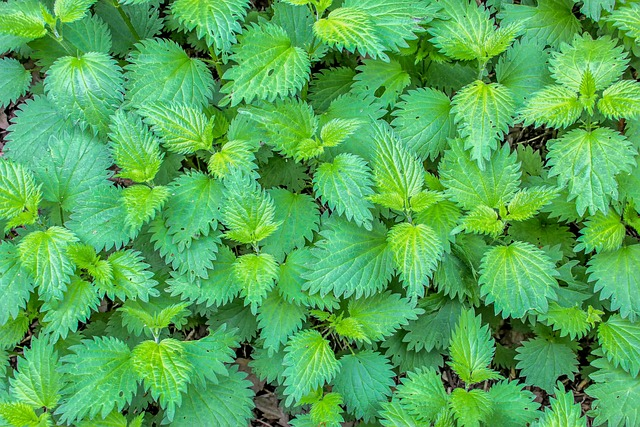Stinging Nettle (Urtica dioica) has been a staple in herbal medicine since ancient times.
MANY NUTRIENTS
Stinging nettle’s leaves and root provide a wide variety of nutrients, including (1):
- Vitamins: Vitamins A, C, and K, as well as several B vitamins
- Minerals: Calcium, iron, magnesium, phosphorus, potassium and sodium
- Fats: Linoleic acid, linolenic acid, palmitic acid, stearic acid and oleic acid
- Amino acids: All of the essential amino acids
- Polyphenols: Kaempferol, quercetin, caffeic acid, coumarins and other flavonoids
- Pigments: Beta-carotene, lutein, luteoxanthin, and other carotenoids
HELPS WITH:
- Relieving arthritis
- Benign Prostatic Hyperplasia (BPH) and Urinary Issues
- Reducing seasonal allergies
- Managing diabetes
- Osteoarthritis and Joint Pain
- Hay Fever
- Bleeding
- Eczema
MORE RESEARCH IS NEEDED, BUT STINGING NETTLE IS ALSO SAID TO:
- Promote lactation
- Stimulate hair growth
- Help control blood sugar in patients with diabetes
- Reduce bleeding connected to gingivitis
- Treat disorders of the kidneys and urinary tract
- Provide relief from water retention
- Prevent or treat diarrhea
- Decrease menstrual flow
- Provide asthma relief
- Heal wounds
- Treat hemorrhoids
- Stimulate contractions in pregnant women
- Treat insect bites
- Treat tendonitis
- Treat anemia
HOW TO USE
Stinging nettle can be harvested or products can be purchased from a local health food store. Before purchasing or making a stinging nettle product, it’s important to identify whether your ailment needs the aboveground parts or the roots, as they have different pharmacological qualities.
Stinging nettle products come in dried or freeze-dried leaf form, extract, capsules, tablets, as well as a root tincture (suspension of the herb in alcohol), juice or tea. There is currently no recommended dose, because so many nettle products have varying amounts of active ingredients. Work with your doctor to determine the right dosage.
SOME OF THE MORE COMMON STINGING NETTLE USES INCLUDE:
1. Nettle Tea
Stinging nettle leaves and flowers can be dried, and the dried leaves can be steeped and made into tea. There are many variations of nettle tea recipes that feature a number of other herbs like raspberry leaf, echinacea, or goldenseal.
Nettle can also be used in other beverages, including even nettle beer.
2. Cooked Nettle
The roots, stems and leaves of stinging nettle are edible. The leaves can be steamed and cooked much like spinach. It’s best to use young leaves. They can be used in nettle soup or added to other soups and stews. Nettle can also be puréed and used in recipes like polenta, green smoothies, salads and pesto. Don’t eat the leaves raw because they will still have the stinging hairs until they are dried or cooked.
When cooked, the nettle has a flavor similar to spinach mixed with cucumber. Cooked nettle is a great source of vitamins A, C, protein, and iron.
3. Topical Nettle
Nettle extracts and root tinctures can be applied directly to joints and painful areas of the body. It’s also available in cream form.
4. Stinging Nettle Capsules and Tablets
Stinging nettle capsules and tablets can be taken orally. There is inconclusive evidence on whether stinging nettle capsules or tablets for allergy relief are better ingested on an empty stomach or not. If there is concern about upset stomach and other side effects, take it with food.
HOW TO TREAT A STINGING NETTLE STING
If stung by the stinging nettle plant, it’s important not to touch or scratch the area. The chemical irritants can dry on the skin and be removed with soap and water. Touching and scratching can push the chemicals further into the skin, extending the irritation time for days. Using duct tape or a wax removal product can help remove any additional fibers.
There are many people who choose dock plant for relief from nettle stings, despite studies showing it does not provide any medicinal benefits aside from making the irritated area feel cool. Crushed leaves from other plants like jewelweed, sage, as well as the stinging nettle leaves themselves release juices that can provide relief from the sting. Other traditional anti-itch treatments like aloe vera, and cold compresses can be used as well.
Once nettle is soaked or cooked in water or dried, the stinging quality is removed.
14 Benefits of Stinging Nettle
1. Pain Reducer
2. Immunity Booster
3. Enhances Digestion
4. Improves Kidney Health
5. Protects Heart Health
6. Manages Diabetes
7. Prevents Osteoporosis
8. Alleviates Osteoarthritis
9. Allergic Reactions Remedy
10. Reduces Menstrual Pain
11. Blood Purifier
12. Promotes Weight Loss
13. Increases Libido
14. Excellent Skin Care
1. Pain Reducer
2. Immunity Booster
3. Enhances Digestion
4. Improves Kidney Health
5. Protects Heart Health
6. Manages Diabetes
7. Prevents Osteoporosis
8. Alleviates Osteoarthritis
9. Allergic Reactions Remedy
10. Reduces Menstrual Pain
11. Blood Purifier
12. Promotes Weight Loss
13. Increases Libido
14. Excellent Skin Care
I ordered it and it tastes pretty good! Nothing like a nice cup of tea at night when it is chilly! 😊
_______________________________________________________
PLEASE DONATE TODAY, IF the Holy Spirit impresses you, (donate button below and on the side) so I can continue to help others. Thank you! If you can't see the donate button or want quick access – use this link: PayPal.Me/ReneeB
Got info from another source.

No comments:
Post a Comment